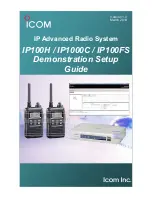
CONVENTIONAL FEATURES
27
algorithm used to generate the 23-bit data word. The
data is transmitted at a rate of 134.4 bits per second.
Therefore, approximately six words are transmitted
each second. When the data is decoded, 23-bit samples
are taken and then the bits are rotated to determine if a
valid code was received.
5.5.5 SELECTIVE SQUELCH CODE SELECT
(CTCSS/DSC/NAC)
NOTE: Call Guard codes may be permanently repro-
grammed by keypad programming (see Section 5.16).
This feature allows the normal transmit and
receive Call Guard (CTCSS/DCS/NAC) program-
ming to be temporarily overridden with a code
selected from a preprogrammed list. It is available if
the
SQ LIST
option switch and a CTCSS/NAC code
list have been programmed.
In addition, with the Handheld Control Unit
(HHC) only, conventional systems can be programmed
for the Keypad CTCSS/DSC feature. Codes can then
be selected directly from the table by pressing the key
for the code. For example, to select code 3 from the
table, simply press the “3” key. No other conventional
mode functions can then be assigned to these keys.
The CTCSS/DCS/NAC list is programmed with
up to 64 tone (CTCSS) or digital (DCS) Call Guard
codes. Different codes can be programmed for the
transmit and receive modes, and carrier squelch (selec-
tive squelch disabled) can be programmed if desired.
In addition, each position can be programmed with an
NAC code for use with P25 operation.
When the Call Guard code is changed using this
feature, it remains selected even if other channels are
selected. However, if radio power is cycled or a talk-
around channel is selected, the normal codes are rese-
lected. When scanning, the selected code also applies
to all scanned channels. If both analog and digital
(Project 25) channels can be selected or scanned, the
CTCSS/DCS code for the selected position is used for
analog channels and the NAC code for the selected
position is used for P25 channels. If a channel is
programmed for mixed mode operation, the selective
squelch type (analog or digital) programmed for the
transmit mode determines the selective squelch type
used.
Proceed as follows to select a code using the
SQ
LIST
option switch:
1. Press the
SQ LIST
option switch and then rotate the
Select switch to select the desired position. The
display indicates “SEL SQ xx” where, “xx” is the
selected code from 1-64.
2. To select the displayed code and return to the normal
display, press the Squelch Code Select switch again.
3. To check which code is selected, press the
SQ LIST
option switch once to display the current selection
and then again to return to normal operation.
4. To return to the normal selective squelch codes,
select “DEFAULT” in this mode. As previously
described, the normal codes are also automatically
reselected whenever radio power is cycled or a talk-
around channel is selected.
5.6 PENALTY TIMER
A penalty timer may be programmed on conven-
tional systems to prevent transmissions for the
programmed time after the time-out timer disables the
transmitter (see Section 4.2). The penalty timer can be
programmed for the same times as the time-out timer,
and timing starts when the PTT switch is released. If
the PTT switch is pressed during the penalty time, the
time-out indication occurs again and the transmitter
remains disabled. When the penalty timer expires, a
beep sounds and the transmitter can then be keyed.
5.7 CONVERSATION TIMER
A conversation timer can be programmed on
conventional systems in addition to the time-out timer
(see Section 4.2). This timer limits that total length of
a conversation rather than just the length of each trans-
mission as with the time-out timer. The following is
more information on this timer.
•
It can be programmed for times up to 7.5 minutes.
•
It is reset when the time between transmissions
exceeds the time programmed for the penalty timer.
•
A warning beep sounds 5 seconds before this timer
disables the transmitter.
•
When this timer disables the transmitter, a contin-
uous tone sounds and the red transmit indicator
















































